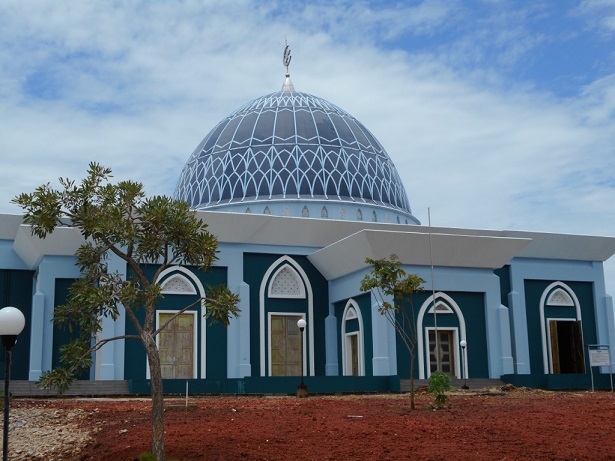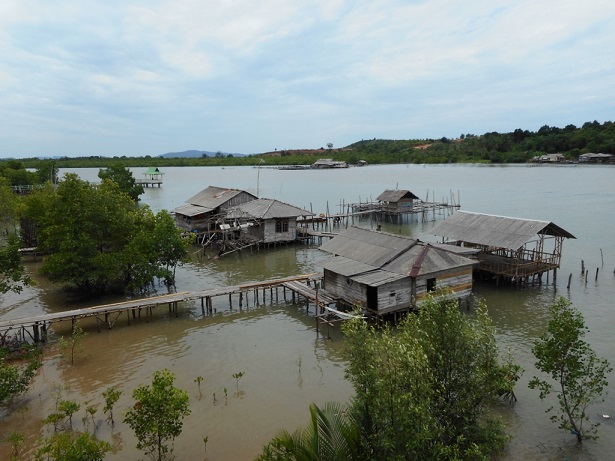Indonesia’s first 'new city' may not be addressing the urban problems it was supposed to
Sarah Moser & Alyssa Shamsa Wilbur
‘There was once clear ocean water here before the new city’s construction. Now, the few of us fishermen left would be lucky to find gonggong (a local delicacy) in this area’. Ruslan, a local fisherman is looking out at his village on Dompak island in Riau Islands province. Dompak is home to the new capital of the Riau Islands, which has been under construction since 2004. Ruslan’s village is one of the last untouched settlements on the island.
Since the mid 1990s, over one hundred new cities have been planned or have commenced construction worldwide. Located almost exclusively in the Global South, these new cities are built by state and private actors to promote city-centric economic growth, to elevate a nation’s status, and transition away from resource-based economies. Other new city projects are constructed to replace a capital city with a new ‘modern’ capital that showcases the state’s aspirations and projects a sense of identity.
Advocates of new cities rationalise them as a strategy for addressing a wide variety of urgent problems facing urban communities: undersupply of housing, rural–urban migration, rapid growth of squatter settlements, congestion, pollution, lack of green space, inefficiency of utilities, to name a few. However, the extent to which new cities successfully address these problems and promote equitable economic growth is questionable, and planning can further entrench social exclusion, as this example of Indonesia’s new city demonstrates.
Indonesia’s new city experiment
Indonesia is a relative latecomer to the growing cohort of countries with new city projects underway. Malaysia started two new cities in the mid 1990s: Putrajaya, the new national administrative capital, and Cyberjaya, a high-tech city intended to become the ‘Silicon Valley’ of Southeast Asia. Subsequently, other emerging economies in Asia, the Middle East, Africa, and Latin America have launched similar state-driven new city projects. In contrast, Indonesia has taken a private sector-driven free market approach to its urban development.
Indonesia’s new city experiment began after the province of Riau split in 2002 and Riau Islands province (Kepulauan Riau, or Kepri) was formed as a result of the wide-ranging decentralisation introduced in the 2000s. The existing centre, Tanjung Pinang, is a small city of roughly 200,000 people previously used by both the colonial Dutch and Japanese as a regional base of operations.
Inspired by Malaysia’s Putrajaya, Kepri government officials decided to shift the provincial capital and increase its size by building modern Indonesia’s first planned city. In 2004, the Kepri administration signed a memorandum of understanding to construct their new capital on nearby Dompak island, situated off the west coast of Bintan. The island has a landmass of approximately 1000 hectares and at the time a population of around 3000 villagers, whose livelihood depended primarily on fishing and other maritime activities.
Despite decentralisation laws designed to encourage regional procurement and benefit local economies, the most lucrative projects for Dompak were awarded to companies from Jakarta, not Riau Islands. Its original goal was to fund the project solely from the province’s regional budget, however Dompak has recently opened up to foreign investment, most notably from a plastic processing company and a cigarette manufacturer.
Dompak was scheduled for completion in 2010, but a combination of regional budget cuts, the mysterious disappearance of state funding and widespread allegations of corruption resulted in significant delays. Excavations for building foundations in Dompak revealed the presence of bauxite, a valuable ingredient used to create aluminium, and resulted in illegal open-pit mining that has thwarted the project’s initial ‘eco city’ goals. The use of heavy mining machinery in the on-going illegal bauxite mining on the island has damaged newly built roads and buildings while undermining the legitimacy of Kepri officials and delaying completion. Nonetheless, Kepri officials remain optimistic about the prospects of the Dompak project, and plans for the city have expanded to include a sports complex, a cable car system and a cultural museum.
Like New Delhi, Brasilia and Putrajaya, which were designed to contrast with Old Delhi, Rio de Janeiro, and Kuala Lumpur, Dompak strives to project ‘modern’ rational values in direct contrast to Tanjung Pinang’s aged, jumbled and multicultural chaos. Dompak draws on design aspects of these other planned cities in the symmetry and formalism of its masterplan.
As of early 2018, the majority of government complexes, a university, and the main mosque have been completed; 140 out of 450 promised resettlement homes have been built; and Dompak now functions as Kepri’s provincial capital. Nonetheless, there is still widespread dissatisfaction and Dompak faces a multitude of criticisms due to its negative environmental impact, continuous and systemic corruption, and the marginalisation of poor residents.
A city of exclusions?
While government officials working on Dompak remain upbeat and continue to expand the project, there is evidence that it is marginalising poor residents and exacerbating racial and religious divisions. Despite official rhetoric of participatory planning, residents who have lived for many generations on this land complain of a lack of consultation and of being forced to sell their land for below-market rates. Those who were relocated were given inadequate housing alternatives, some relocated to single-family units, which split up extended families and destroyed close-knit communities.
A majority of the replacement housing was built in isolated locations far from the ocean, the main source of residents’ livelihood. One resident threatened with relocation stated, ‘it would have been nice if they [government officials] consulted us as to where our new homes would be. Many of my neighbours who have been relocated must walk over two kilometres over the hill to get to the waterfront, and when I have to move, I just worry that my sampan (small boat) will get stolen’.
Moreover, many have been relocated to poor quality land that is not yet serviced with running water or electricity, despite official promises of improved housing. To make matters worse, the construction of the city and illegal mining operations caused a massive outbreak of malaria and dengue for which residents have received no government assistance.
The masterplan of Dompak makes it clear that long-term residents do not fit into the modern utopian vision for the city. For example, some are being pressured to relocate to make way for two golf courses to cater to civil servants and tourists.

Emulating the ethno-nationalism manifested in Putrajaya, a central aim of Dompak is to prioritise Malays while rendering other ethnic and religious groups invisible. Indeed, the city’s official vision states that Dompak is to be a capital city ‘designed using concepts that highlight the nuances of Malay culture’. This has been accomplished by shifting government functions away from the ethnically mixed city of Tanjung Pinang to a city designed to be ‘khas Melayu’ (specifically Malay), a move that symbolically excludes ethnic Chinese and other minorities. The architecture of Dompak projects a solely Arabised-Muslim identity through large domed rooftops, arched shaped doors and windows, tall minarets, and Arabic inscriptions – a departure from the syncretic and multi-cultural architecture of Tanjung Pinang.
While ethnic Chinese constitute almost 15 per cent of Kepri’s population, Dompak has only included structures for Muslims (an Islamic centre, a mosque and an Islamic university) and even secular government buildings have an unmistakable Muslim character. No Chinese religious buildings, cemeteries, or businesses are included in the plans for the city. While Kepri has a long been a region characterised by a peaceful co-existence between Malays and Chinese, Dompak represents a troubling step towards state-sponsored ethno-nationalism.
A new era of master-planned cities in Indonesia?
Dompak marks the beginning of an important trend in Indonesian urban planning and deserves further critical attention. In the coming decades, hundreds of millions of dollars will be channeled into the design and execution of such utopian projects in Indonesia. Despite Dompak’s many shortcomings, it is seen as a template for the construction of new cities in several municipalities in Java. It was recently announced that Indonesia is planning to build at least ten more new cities across the archipelago.
Dompak is nothing short of a fiasco that embodies Indonesia’s corruption and cronyism, in a highly visible public project on a grand scale. The project, however, presents an opportunity for others to learn from its mistakes and avoid creating more new cities that benefit the rich and powerful, while disadvantaging the poor and aggravating racial and religious tensions.
Sarah Moser (sarah.moser@mcgill.ca / @sarahkmoser) is a professor in the Department of Geography at McGill University. Sarah’s broader research examines the global phenomenon of new master-planned cities and she is currently working on an Atlas of New Cities, which profiles 100 new city projects underway. She also examines the interplay between Islam, ethno-nationalism, and new urban development.
Alyssa Wilbur (alyssa.wilbur@mail.mcgill.ca / @alyssawilbur) is a graduate student in the Department of Geography at McGill University. Her research explores urban policies and their social impact. Specifically, her master’s project focuses on Dompak and the various social exclusions that this new city creates.
